Differential Host Responses and Viral Replication of Highly Pathogenic Avian Influenza H5N1 Strains in Diverse Cell Lines with a Raw Milk Supplement
Abstract
1. Introduction
2. Materials and Methods
2.1. Cells and Viruses
2.2. Raw Milk Processing and Infection Medium Preparation
- Normal Infection Medium: Prepared by mixing sterile cell culture grade water (ThermoFisher Scientific, Waltham, MA, USA) 1:1 with 2X Minimum Essential Medium (MEM) (Millipore Sigma) containing 2X antibiotic-antimycotic solution (ThermoFisher Scientific, Waltham, MA, USA).
- Milk-Supplemented Infection Medium: Prepared by mixing the processed raw milk (as described above) 1:1 with 2X MEM (Millipore Sigma, Burlington, MA, USA) containing 2X antibiotic-antimycotic solution (ThermoFisher Scientific, Waltham, MA, USA).
2.3. Virus Infections
2.4. RNA Extraction
2.5. Reverse Transcription Real-Time PCR (RT-qPCR) Assays for Quantifying Influenza a Genome
2.6. Determination of Virus Infectious Particles from Ct Values
2.7. RNA-Seq Library Preparation and Sequencing Using Illumina Short Read Technology
2.8. Bioinformatics Analysis
2.8.1. Variant Calling Analysis
- Alignment: Samples from bovine-H5N1 infected cells were aligned against the full genome sequence of A/dairy cattle/Kansas/5/2024 (NCBI GenBank ID PP732373-80). Samples from mink H5N1-infected cells were aligned against the full genome sequence of A/Mink/Spain/3691-8_22VIR10586-10/2022 (GISAID ID EPI2220590-97) (Table 1).
- Variant Detection: Variant detection parameters within SeqMan Ultra included a Minimum Score at SNP of 5.
- Visualization: The results of the variant calling analysis were visualized using GraphPad Prism (version 10, GraphPad Software, Boston, MA, USA).
2.8.2. Differential Gene Expression (DGE) Analysis
- Quality Control and Trimming: Raw sequences were first trimmed to remove adapter sequences and low-quality bases using Trimmomatic version 0.39 [28].
- Gene Counting: Aligned reads were then used to quantify gene expression by counting reads per transcript using StringTie version 2.2.1 [30].
- Differential Expression Analysis: Raw gene counts were imported into R statistical software (R Core Team, 2024) and analyzed for differential gene expression using the DESeq2 package version 1.49.3 [31]. DESeq2 employs a negative binomial generalized linear model to identify genes with statistically significant changes in expression between experimental conditions. Genes with an adjusted p-value (FDR) < 0.05 and an absolute log2 fold change > 1 were considered differentially expressed.
- Visualization: Boxplots showing the expression distributions of selected differentially expressed genes were generated in Python version 3.12.5 using the seaborn library [32].
- Functional Enrichment Analysis: The top upregulated and downregulated genes were further analyzed for gene function enrichment using the Metascape online platform (https://metascape.org, accessed on 21 August 2024) [33]. Enriched pathways and biological processes were visualized using the ggplot2 package version 3.5.2 in R version 4.4.1 [34].
2.9. Statistical Analysis
2.9.1. Viral Replication Analysis
2.9.2. RNA-Sequencing Differential Expression Analysis
3. Results
3.1. Replication Efficiency of HPAIV H5N1 Strains in Mammalian Cell Lines Is Affected by the Addition of Raw Milk
3.2. Viral Genomic Adaptation Evident from Amino Acid Mutations
3.3. Global Transcriptomic Changes Reveal Robust Antiviral Responses Dependent on Cell Type and Raw Milk
3.4. Modulation of Specific Host Gene Expression by H5N1 Infection and Raw Milk
3.4.1. Modulation of Genes Involved in Entry, Adsorption, and Uncoating
3.4.2. Modulation of Genes Involved in Genome Replication, Trafficking, and Protein Synthesis
3.4.3. Modulation of Host Antiviral Responses
3.4.4. Host Signaling, Trafficking, and Assembly Pathways
4. Discussion
5. Future Research Directions
6. Limitations
Supplementary Materials
Author Contributions
Funding
Institutional Review Board Statement
Informed Consent Statement
Data Availability Statement
Acknowledgments
Conflicts of Interest
References
- Taubenberger, J.K.; Kash, J.C. Influenza Virus Evolution, Host Adaptation, and Pandemic Formation. Cell Host Microbe 2010, 7, 440–451. [Google Scholar] [CrossRef]
- Lowen, A.C. Constraints, Drivers, and Implications of Influenza A Virus Reassortment. Annu. Rev. Virol. 2017, 4, 105–121. [Google Scholar] [CrossRef]
- Webster, R.G.; Bean , W.J.; Gorman , O.T.; Chambers , T.M.; Kawaoka , Y. Evolution and Ecology of Influenza A Viruses. In Influenza Pathogenesis and Control—Volume I; Compans, R.W., Oldstone, M.B.A., Eds.; Springer International Publishing: Cham, Switzerland, 2014; pp. 359–375. ISBN 978-3-319-11155-1. [Google Scholar]
- Pauly, M.D.; Procario, M.C.; Lauring, A.S. A Novel Twelve Class Fluctuation Test Reveals Higher than Expected Mutation Rates for Influenza A Viruses. eLife 2017, 6, e26437. [Google Scholar] [CrossRef]
- Sanjuán, R.; Nebot, M.R.; Chirico, N.; Mansky, L.M.; Belshaw, R. Viral Mutation Rates. J. Virol. 2010, 84, 9733–9748. [Google Scholar] [CrossRef]
- Nobusawa, E.; Sato, K. Comparison of the Mutation Rates of Human Influenza A and B Viruses. J. Virol. 2006, 80, 3675–3678. [Google Scholar] [CrossRef]
- Wan, X.F. Lessons from Emergence of A/Goose/Guangdong/1996-Like H5N1 Highly Pathogenic Avian Influenza Viruses and Recent Influenza Surveillance Efforts in Southern China. Zoonoses Public Health 2012, 59, 32–42. [Google Scholar] [CrossRef]
- Guo, Y.; Xu, X.; Wan, X. Genetic characterization of an avian influenza A (H5N1) virus isolated from a sick goose in China. Zhonghua Shi Yan He Lin Chuang Bing Du Xue Za Zhi 1998, 12, 322–325. [Google Scholar]
- CDC Technical Report: June 2024 Highly Pathogenic Avian Influenza A (H5N1) Viruses. Available online: https://www.cdc.gov/bird-flu/php/technical-report/h5n1-06052024.html (accessed on 11 August 2025).
- Webby, R.J.; Uyeki, T.M. An Update on Highly Pathogenic Avian Influenza A (H5N1) Virus, Clade 2.3.4.4b. J. Infect. Dis. 2024, 230, 533–542. [Google Scholar] [CrossRef]
- Xie, Z.; Yang, J.; Jiao, W.; Li, X.; Iqbal, M.; Liao, M.; Dai, M. Clade 2.3.4.4b Highly Pathogenic Avian Influenza H5N1 Viruses: Knowns, Unknowns, and Challenges. J. Virol. 2025, 99, e00424-25. [Google Scholar] [CrossRef]
- Bordes, L.; Vreman, S.; Heutink, R.; Roose, M.; Venema, S.; Pritz-Verschuren, S.B.E.; Rijks, J.M.; Gonzales, J.L.; Germeraad, E.A.; Engelsma, M.; et al. Highly Pathogenic Avian Influenza H5N1 Virus Infections in Wild Red Foxes (Vulpes vulpes) Show Neurotropism and Adaptive Virus Mutations. Microbiol. Spectr. 2023, 11, e02867-22. [Google Scholar] [CrossRef]
- Agüero, M.; Monne, I.; Sánchez, A.; Zecchin, B.; Fusaro, A.; Ruano, M.J.; Arrojo, M.d.V.; Fernández-Antonio, R.; Souto, A.M.; Tordable, P.; et al. Highly Pathogenic Avian Influenza A (H5N1) Virus Infection in Farmed Minks, Spain, October 2022. Eurosurveillance 2023, 28, 2300001. [Google Scholar] [CrossRef]
- Burrough, E.R.; Magstadt, D.R.; Petersen, B.; Timmermans, S.J.; Gauger, P.C.; Zhang, J.; Siepker, C.; Mainenti, M.; Li, G.; Thompson, A.C.; et al. Highly Pathogenic Avian Influenza A (H5N1) Clade 2.3.4.4b Virus Infection in Domestic Dairy Cattle and Cats, United States, 2024. Emerg. Infect. Dis. 2024, 30, 1335. [Google Scholar] [CrossRef]
- Leguia, M.; Garcia-Glaessner, A.; Muñoz-Saavedra, B.; Juarez, D.; Barrera, P.; Calvo-Mac, C.; Jara, J.; Silva, W.; Ploog, K.; Amaro, L.; et al. Highly Pathogenic Avian Influenza A (H5N1) in Marine Mammals and Seabirds in Peru. Nat. Commun. 2023, 14, 5489. [Google Scholar] [CrossRef]
- Youk, S.; Torchetti, M.K.; Lantz, K.; Lenoch, J.B.; Killian, M.L.; Leyson, C.; Bevins, S.N.; Dilione, K.; Ip, H.S.; Stallknecht, D.E.; et al. H5N1 Highly Pathogenic Avian Influenza Clade 2.3.4.4b in Wild and Domestic Birds: Introductions into the United States and Reassortments, December 2021–April 2022. Virology 2023, 587, 109860. [Google Scholar] [CrossRef]
- Peacock, T.P.; Moncla, L.; Dudas, G.; VanInsberghe, D.; Sukhova, K.; Lloyd-Smith, J.O.; Worobey, M.; Lowen, A.C.; Nelson, M.I. The Global H5N1 Influenza Panzootic in Mammals. Nature 2025, 637, 304–313. [Google Scholar] [CrossRef]
- Baker, A.L.; Arruda, B.; Palmer, M.V.; Boggiatto, P.; Davila, K.S.; Buckley, A.; Zanella, G.C.; Snyder, C.A.; Anderson, T.K.; Hutter, C.R.; et al. Dairy Cows Inoculated with Highly Pathogenic Avian Influenza Virus H5N1. Nature 2024, 637, 913–920. [Google Scholar] [CrossRef]
- Caserta, L.C.; Frye, E.A.; Butt, S.L.; Laverack, M.; Nooruzzaman, M.; Covaleda, L.M.; Thompson, A.C.; Koscielny, M.P.; Cronk, B.; Johnson, A.; et al. Spillover of Highly Pathogenic Avian Influenza H5N1 Virus to Dairy Cattle. Nature 2024, 634, 669–676. [Google Scholar] [CrossRef]
- Halwe, N.J.; Cool, K.; Breithaupt, A.; Schön, J.; Trujillo, J.D.; Nooruzzaman, M.; Kwon, T.; Ahrens, A.K.; Britzke, T.; McDowell, C.D.; et al. Outcome of H5N1 Clade 2.3.4.4b Virus Infection in Calves and Lactating Cows. bioRxiv 2024. [Google Scholar] [CrossRef]
- Nelli, R.K.; Harm, T.A.; Siepker, C.; Groeltz-Thrush, J.M.; Jones, B.; Twu, N.-C.; Nenninger, A.S.; Magstadt, D.R.; Burrough, E.R.; Piñeyro, P.E.; et al. Sialic Acid Receptor Specificity in Mammary Gland of Dairy Cattle Infected with Highly Pathogenic Avian Influenza A (H5N1) Virus. Emerg. Infect. Dis. J. 2024, 30, 1361. [Google Scholar] [CrossRef]
- Kristensen, C.; Jensen, H.E.; Trebbien, R.; Webby, R.J.; Larsen, L.E. Avian and Human Influenza A Virus Receptors in Bovine Mammary Gland. Emerg. Infect. Dis. J. 2024, 30, 1907. [Google Scholar] [CrossRef]
- Ríos Carrasco, M.; Gröne, A.; van den Brand, J.M.A.; de Vries, R.P. The Mammary Glands of Cows Abundantly Display Receptors for Circulating Avian H5 Viruses. J. Virol. 2024, 98, e01052-24. [Google Scholar] [CrossRef]
- Guan, L.; Eisfeld, A.J.; Pattinson, D.; Gu, C.; Biswas, A.; Maemura, T.; Trifkovic, S.; Babujee, L.; Presler, R.; Dahn, R.; et al. Cow’s Milk Containing Avian Influenza A (H5N1) Virus—Heat Inactivation and Infectivity in Mice. N. Engl. J. Med. 2024, 391, 87–90. [Google Scholar] [CrossRef]
- Frye, E.A.; Nooruzzaman, M.; Cronk, B.; Laverack, M.; de Oliveira, P.S.B.; Caserta, L.C.; Lejeune, M.; Diel, D.G. Isolation of Highly Pathogenic Avian Influenza A (H5N1) Virus from Cat Urine after Raw Milk Ingestion, United States. Emerg. Infect. Dis. J. 2025, 31, 1636. [Google Scholar] [CrossRef]
- Singh, G.; Trujillo, J.D.; McDowell, C.D.; Matias-Ferreyra, F.; Kafle, S.; Kwon, T.; Gaudreault, N.N.; Fitz, I.; Noll, L.; Morozov, I.; et al. Detection and Characterization of H5N1 HPAIV in Environmental Samples from a Dairy Farm. Virus Genes 2024, 60, 517–527. [Google Scholar] [CrossRef]
- Singh, G.; Kafle, S.; Assato, P.; Goraya, M.; Morozov, I.; Richt, J.A. Single-Cell Analysis of Host Responses in Bovine Milk Somatic Cells (bMSCs) Following HPAIV Bovine H5N1 Influenza Exposure. Viruses 2025, 17, 811. [Google Scholar] [CrossRef]
- Bolger, A.M.; Lohse, M.; Usadel, B. Trimmomatic: A Flexible Trimmer for Illumina Sequence Data. Bioinformatics 2014, 30, 2114–2120. [Google Scholar] [CrossRef]
- Kim, D.; Langmead, B.; Salzberg, S.L. HISAT: A Fast Spliced Aligner with Low Memory Requirements. Nat. Methods 2015, 12, 357–360. [Google Scholar] [CrossRef]
- Pertea, M.; Pertea, G.M.; Antonescu, C.M.; Chang, T.-C.; Mendell, J.T.; Salzberg, S.L. StringTie Enables Improved Reconstruction of a Transcriptome from RNA-Seq Reads. Nat. Biotechnol. 2015, 33, 290–295. [Google Scholar] [CrossRef]
- Love, M.I.; Huber, W.; Anders, S. Moderated Estimation of Fold Change and Dispersion for RNA-Seq Data with DESeq2. Genome Biol. 2014, 15, 550. [Google Scholar] [CrossRef]
- Waskom, M.L. Seaborn: Statistical Data Visualization. J. Open Source Softw. 2021, 6, 3021. [Google Scholar] [CrossRef]
- Zhou, Y.; Zhou, B.; Pache, L.; Chang, M.; Khodabakhshi, A.H.; Tanaseichuk, O.; Benner, C.; Chanda, S.K. Metascape Provides a Biologist-Oriented Resource for the Analysis of Systems-Level Datasets. Nat. Commun. 2019, 10, 1523. [Google Scholar] [CrossRef]
- Wickham, H. Ggplot2: Elegant Graphics for Data Analysis; Springer: New York, NY, USA, 2009; ISBN 978-0-387-98140-6. [Google Scholar]
- Ashenberg, O.; Padmakumar, J.; Doud, M.B.; Bloom, J.D. Deep Mutational Scanning Identifies Sites in Influenza Nucleoprotein That Affect Viral Inhibition by MxA. PLoS Pathog. 2017, 13, e1006288. [Google Scholar] [CrossRef]
- Chenavier, F.; Estrozi, L.F.; Teulon, J.-M.; Zarkadas, E.; Freslon, L.-L.; Pellequer, J.-L.; Ruigrok, R.W.H.; Schoehn, G.; Ballandras-Colas, A.; Crépin, T. Cryo-EM Structure of Influenza Helical Nucleocapsid Reveals NP-NP and NP-RNA Interactions as a Model for the Genome Encapsidation. Sci. Adv. 2023, 9, eadj9974. [Google Scholar] [CrossRef]
- Han, J.; Perez, J.T.; Chen, C.; Li, Y.; Benitez, A.; Kandasamy, M.; Lee, Y.; Andrade, J.; tenOever, B.; Manicassamy, B. Genome-Wide CRISPR/Cas9 Screen Identifies Host Factors Essential for Influenza Virus Replication. Cell Rep. 2018, 23, 596–607. [Google Scholar] [CrossRef]
- Ma, T.; Niu, S.; Wu, Z.; Pan, S.; Wang, C.; Shi, X.; Yan, M.; Xu, B.; Liu, X.; Li, L.; et al. Genome-Wide CRISPR Screen Identifies GNE as a Key Host Factor That Promotes Influenza A Virus Adsorption and Endocytosis. Microbiol. Spectr. 2023, 11, e01643-23. [Google Scholar] [CrossRef]
- Watanabe, T.; Watanabe, S.; Kawaoka, Y. Cellular Networks Involved in the Influenza Virus Life Cycle. Cell Host Microbe 2010, 7, 427–439. [Google Scholar] [CrossRef]
- Mehle, A.; Doudna, J.A. A Host of Factors Regulating Influenza Virus Replication. Viruses 2010, 2, 566–573. [Google Scholar] [CrossRef]
- Stertz, S.; Shaw, M.L. Uncovering the Global Host Cell Requirements for Influenza Virus Replication via RNAi Screening. Microbes Infect. 2011, 13, 516–525. [Google Scholar] [CrossRef]
- Wilczynska, A.; Gillen, S.L.; Schmidt, T.; Meijer, H.A.; Jukes-Jones, R.; Langlais, C.; Kopra, K.; Lu, W.-T.; Godfrey, J.D.; Hawley, B.R.; et al. eIF4A2 Drives Repression of Translation at Initiation by Ccr4-Not through Purine-Rich Motifs in the 5′UTR. Genome Biol. 2019, 20, 262. [Google Scholar] [CrossRef]
- Wang, S.; Chi, X.; Wei, H.; Chen, Y.; Chen, Z.; Huang, S.; Chen, J.-L. Influenza A Virus-Induced Degradation of Eukaryotic Translation Initiation Factor 4B Contributes to Viral Replication by Suppressing IFITM3 Protein Expression. J. Virol. 2014, 88, 8375–8385. [Google Scholar] [CrossRef]
- Satterly, N.; Tsai, P.-L.; van Deursen, J.; Nussenzveig, D.R.; Wang, Y.; Faria, P.A.; Levay, A.; Levy, D.E.; Fontoura, B.M.A. Influenza Virus Targets the mRNA Export Machinery and the Nuclear Pore Complex. Proc. Natl. Acad. Sci. USA 2007, 104, 1853–1858. [Google Scholar] [CrossRef]
- Bhat, P.; Aksenova, V.; Gazzara, M.; Rex, E.A.; Aslam, S.; Haddad, C.; Gao, S.; Esparza, M.; Cagatay, T.; Batten, K.; et al. Influenza Virus mRNAs Encode Determinants for Nuclear Export via the Cellular TREX-2 Complex. Nat. Commun. 2023, 14, 2304. [Google Scholar] [CrossRef]
- Pashkov, E.; Korchevaya, E.; Faizuloev, E.; Rtishchev, A.; Cherepovich, B.; Bystritskaya, E.; Sidorov, A.; Poddubikov, A.; Bykov, A.; Dronina, Y.; et al. Knockdown of FLT4, Nup98, and Nup205 Cellular Genes Effectively Suppresses the Reproduction of Influenza Virus Strain A/WSN/1933 (H1N1) In Vitro. Infect. Disord.-Drug Targets 2022, 22, 100–108. [Google Scholar] [CrossRef]
- Nakada, R.; Hirano, H.; Matsuura, Y. Structure of Importin-α Bound to a Non-Classical Nuclear Localization Signal of the Influenza A Virus Nucleoprotein. Sci. Rep. 2015, 5, 15055. [Google Scholar] [CrossRef]
- Kurokawa, C.; Iankov, I.D.; Galanis, E. A Key Anti-Viral Protein, RSAD2/VIPERIN, Restricts the Release of Measles Virus from Infected Cells. Virus Res. 2019, 263, 145–150. [Google Scholar] [CrossRef]
- Zhang, J.; Huang, F.; Tan, L.; Bai, C.; Chen, B.; Liu, J.; Liang, J.; Liu, C.; Zhang, S.; Lu, G.; et al. Host Protein Moloney Leukemia Virus 10 (MOV10) Acts as a Restriction Factor of Influenza A Virus by Inhibiting the Nuclear Import of the Viral Nucleoprotein. J. Virol. 2016, 90, 3966–3980. [Google Scholar] [CrossRef]
- Nenasheva, V.V.; Nikitenko, N.A.; Stepanenko, E.A.; Makarova, I.V.; Andreeva, L.E.; Kovaleva, G.V.; Lysenko, A.A.; Tukhvatulin, A.I.; Logunov, D.Y.; Tarantul, V.Z. Human TRIM14 Protects Transgenic Mice from Influenza A Viral Infection without Activation of Other Innate Immunity Pathways. Genes Immun. 2021, 22, 56–63. [Google Scholar] [CrossRef]
- Wu, X.; Wang, J.; Wang, S.; Wu, F.; Chen, Z.; Li, C.; Cheng, G.; Qin, F.X.-F. Inhibition of Influenza A Virus Replication by TRIM14 via Its Multifaceted Protein–Protein Interaction with NP. Front. Microbiol. 2019, 10, 344. [Google Scholar] [CrossRef]
- Choudhury, N.R.; Trus, I.; Heikel, G.; Wolczyk, M.; Szymanski, J.; Bolembach, A.; Dos Santos Pinto, R.M.; Smith, N.; Trubitsyna, M.; Gaunt, E.; et al. TRIM25 Inhibits Influenza A Virus Infection, Destabilizes Viral mRNA, but Is Redundant for Activating the RIG-I Pathway. Nucleic Acids Res. 2022, 50, 7097–7114. [Google Scholar] [CrossRef]
- Gack, M.U.; Albrecht, R.A.; Urano, T.; Inn, K.-S.; Huang, I.-C.; Carnero, E.; Farzan, M.; Inoue, S.; Jung, J.U.; García-Sastre, A. Influenza A Virus NS1 Targets the Ubiquitin Ligase TRIM25 to Evade Recognition by the Host Viral RNA Sensor RIG-I. Cell Host Microbe 2009, 5, 439–449. [Google Scholar] [CrossRef]
- Lin, L.; Wang, X.; Chen, Z.; Deng, T.; Yan, Y.; Dong, W.; Huang, Y.; Zhou, J. TRIM21 Restricts Influenza A Virus Replication by Ubiquitination-Dependent Degradation of M1. PLoS Pathog. 2023, 19, e1011472. [Google Scholar] [CrossRef]
- Li, Y.; Banerjee, S.; Wang, Y.; Goldstein, S.A.; Dong, B.; Gaughan, C.; Silverman, R.H.; Weiss, S.R. Activation of RNase L Is Dependent on OAS3 Expression during Infection with Diverse Human Viruses. Proc. Natl. Acad. Sci. USA 2016, 113, 2241–2246. [Google Scholar] [CrossRef]
- Artarini, A.; Meyer, M.; Shin, Y.J.; Huber, K.; Hilz, N.; Bracher, F.; Eros, D.; Orfi, L.; Keri, G.; Goedert, S.; et al. Regulation of Influenza A Virus mRNA Splicing by CLK1. Antivir. Res. 2019, 168, 187–196. [Google Scholar] [CrossRef]
- Ren, C.; Chen, T.; Zhang, S.; Gao, Q.; Zou, J.; Li, P.; Wang, B.; Zhao, Y.; OuYang, A.; Suolang, S.; et al. PLK3 Facilitates Replication of Swine Influenza Virus by Phosphorylating Viral NP Protein. Emerg. Microbes Infect. 2023, 12, 2275606. [Google Scholar] [CrossRef] [PubMed]
- Luig, C.; Köther, K.; Dudek, S.E.; Gaestel, M.; Hiscott, J.; Wixler, V.; Ludwig, S. MAP Kinase-Activated Protein Kinases 2 and 3 Are Required for Influenza A Virus Propagation and Act via Inhibition of PKR. FASEB J. 2010, 24, 4068–4077. [Google Scholar] [CrossRef]
- Zhou, A.; Zhang, W.; Wang, B. Host Factor TNK2 Is Required for Influenza Virus Infection. Genes Genom. 2023, 45, 771–781. [Google Scholar] [CrossRef]
- Sun, E.; He, J.; Zhuang, X. Dissecting the Role of COPI Complexes in Influenza Virus Infection. J. Virol. 2013, 87, 2673–2685. [Google Scholar] [CrossRef]
- Hu, Y.; Jiang, L.; Lai, W.; Qin, Y.; Zhang, T.; Wang, S.; Ye, X. MicroRNA-33a Disturbs Influenza A Virus Replication by Targeting ARCN1 and Inhibiting Viral Ribonucleoprotein Activity. J. Gen. Virol. 2016, 97, 27–38. [Google Scholar] [CrossRef]
- Imai, M.; Watanabe, T.; Hatta, M.; Das, S.C.; Ozawa, M.; Shinya, K.; Zhong, G.; Hanson, A.; Katsura, H.; Watanabe, S.; et al. Experimental Adaptation of an Influenza H5 HA Confers Respiratory Droplet Transmission to a Reassortant H5 HA/H1N1 Virus in Ferrets. Nature 2012, 486, 420–428. [Google Scholar] [CrossRef]
- Wilker, P.R.; Dinis, J.M.; Starrett, G.; Imai, M.; Hatta, M.; Nelson, C.W.; O’Connor, D.H.; Hughes, A.L.; Neumann, G.; Kawaoka, Y.; et al. Selection on Haemagglutinin Imposes a Bottleneck during Mammalian Transmission of Reassortant H5N1 Influenza Viruses. Nat. Commun. 2013, 4, 2636. [Google Scholar] [CrossRef] [PubMed]
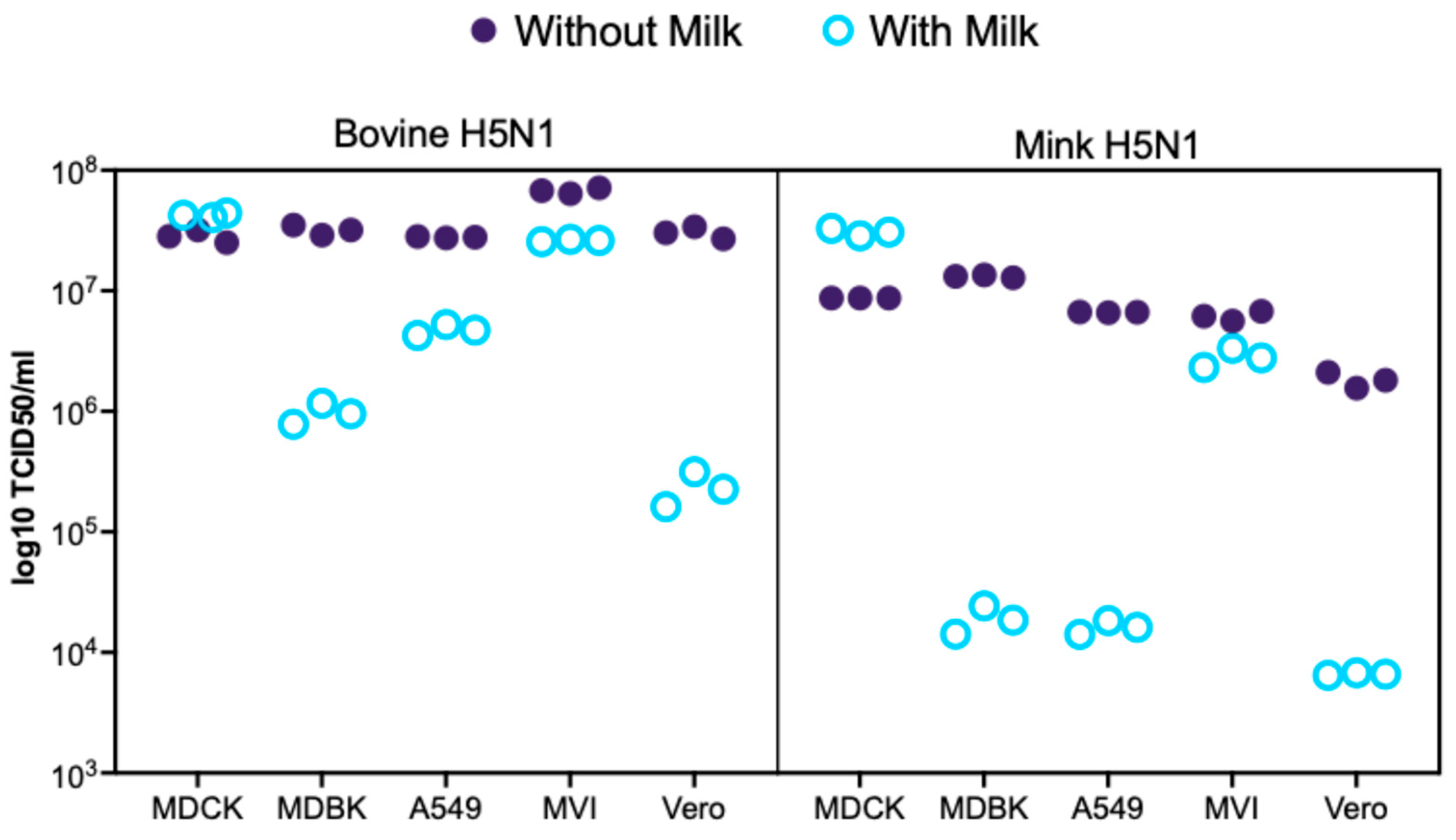
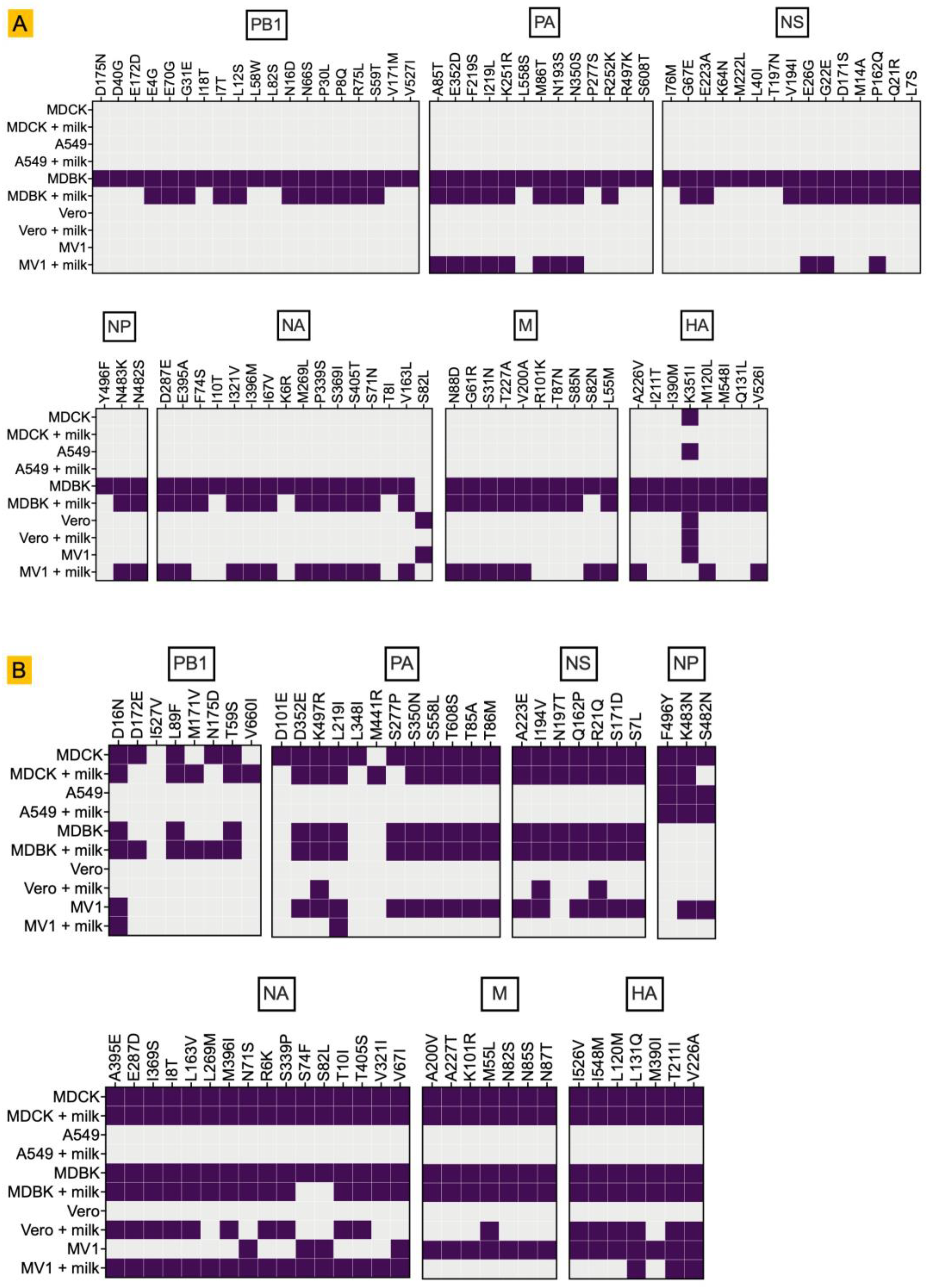
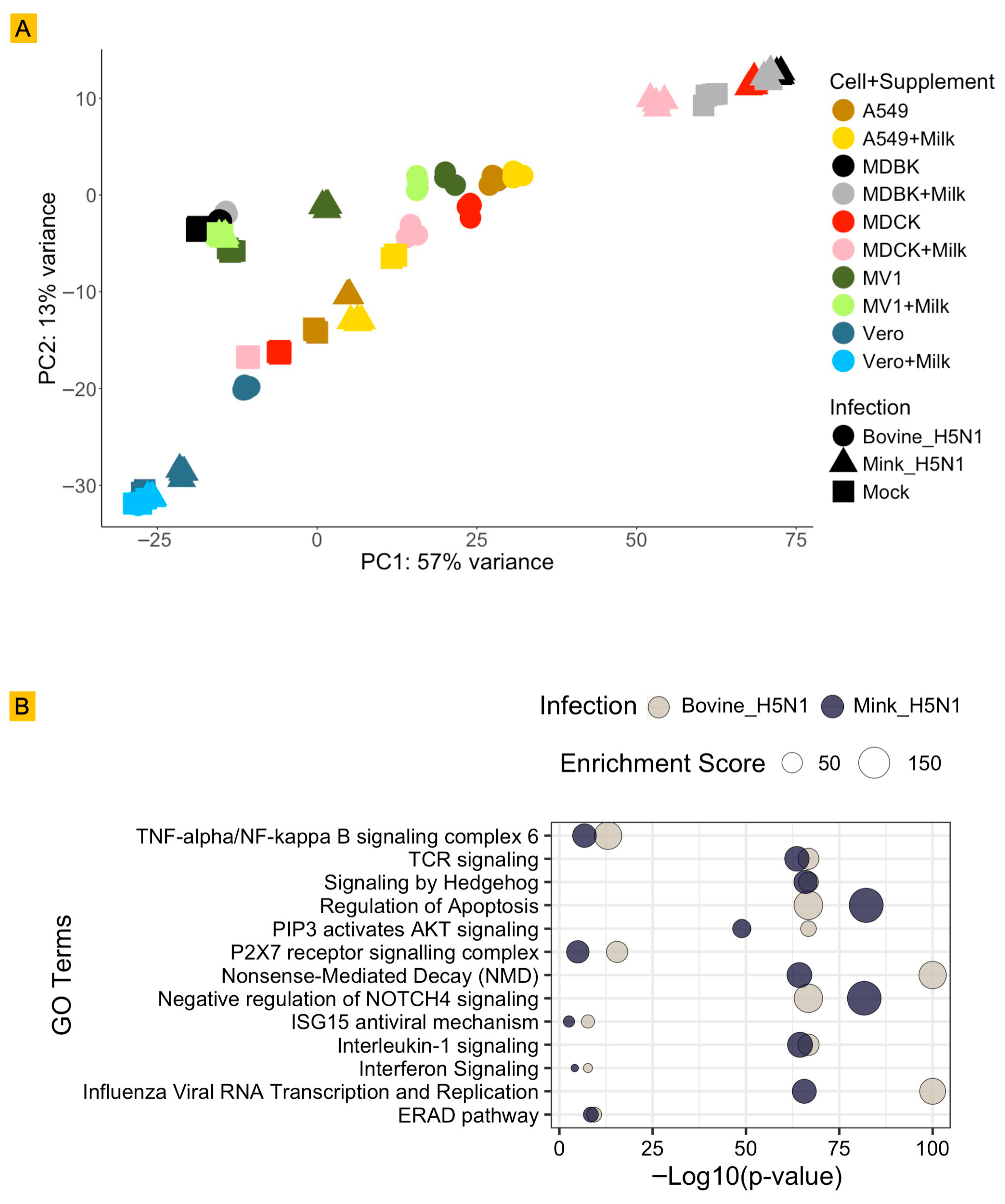

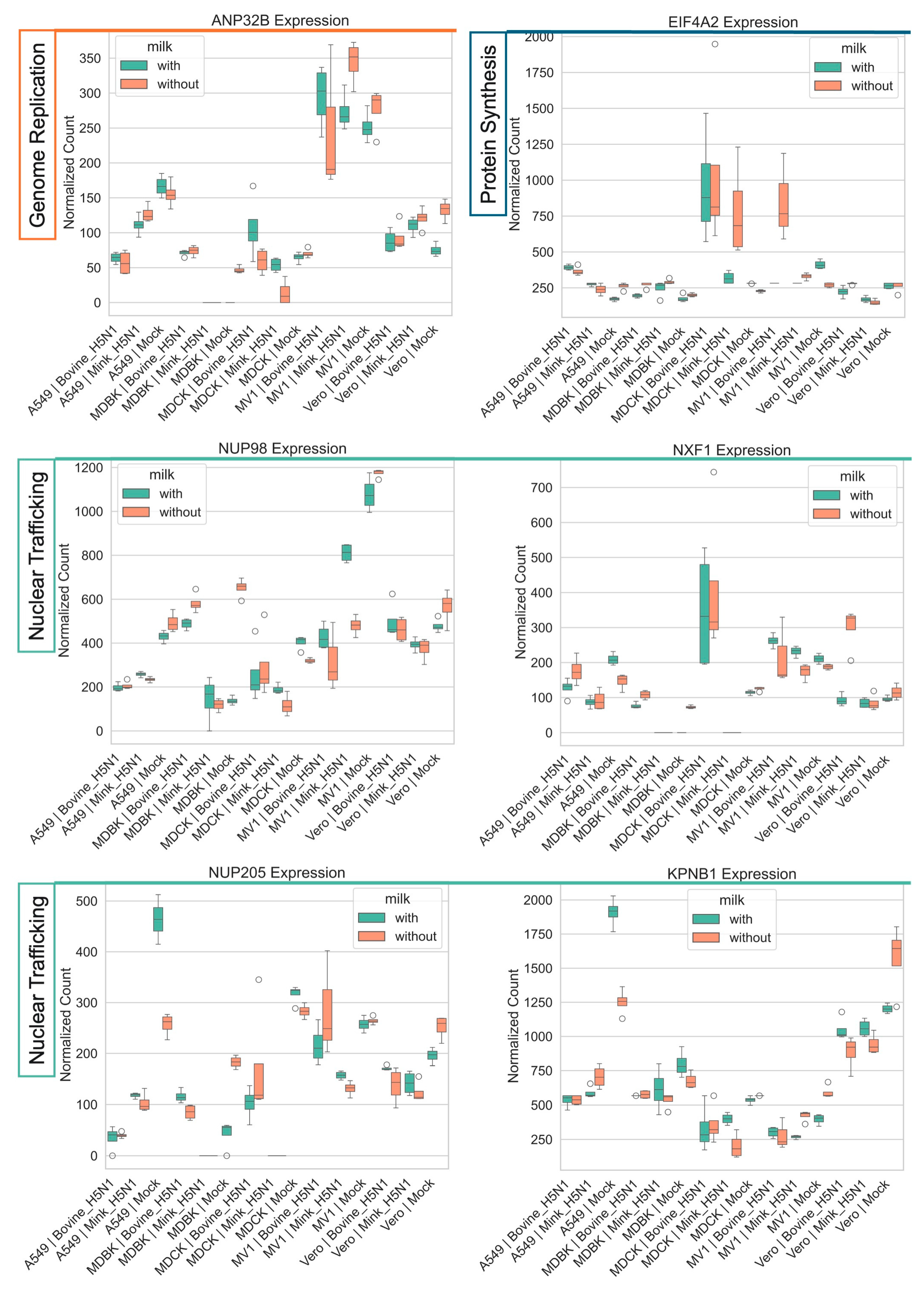
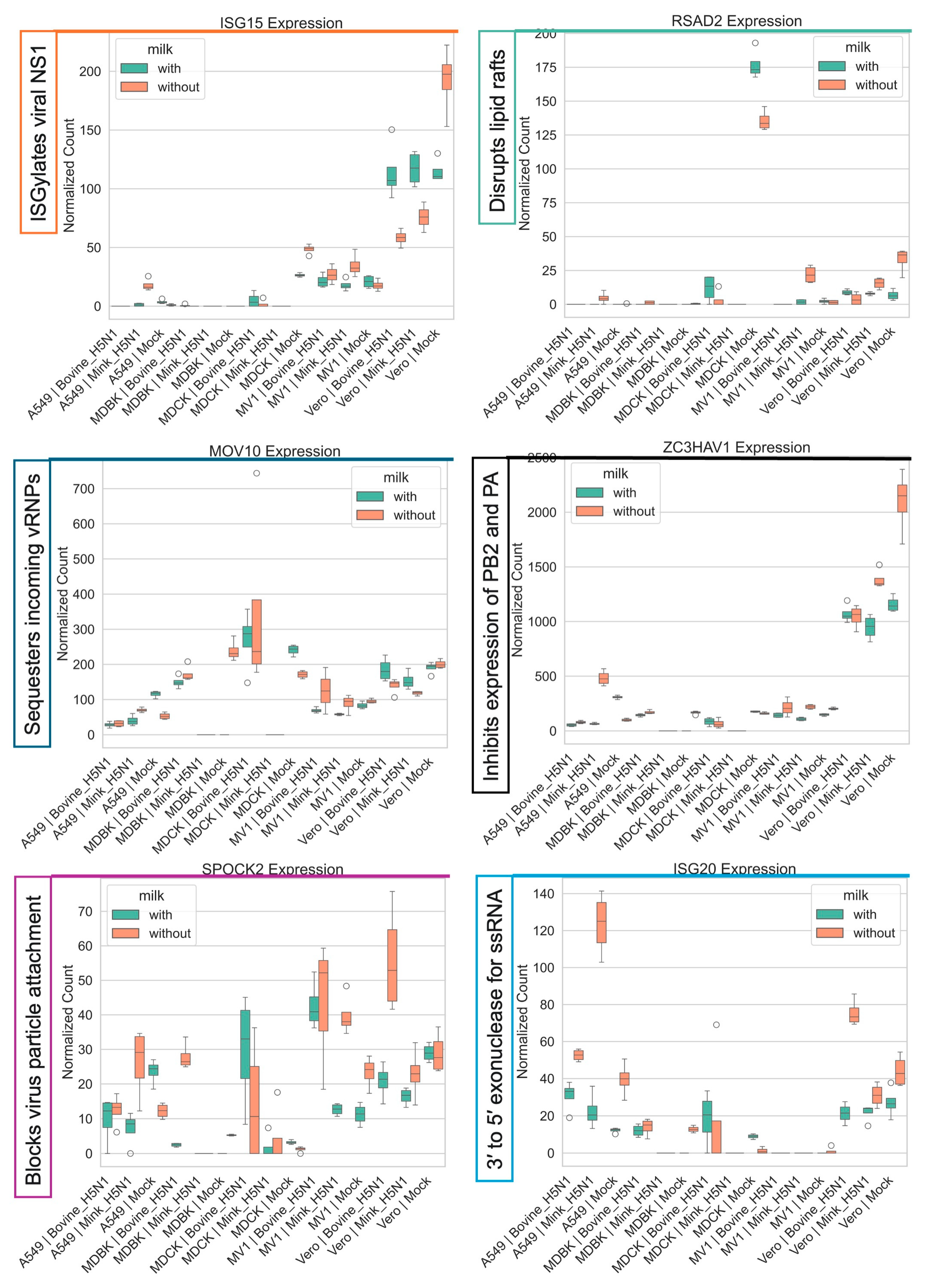
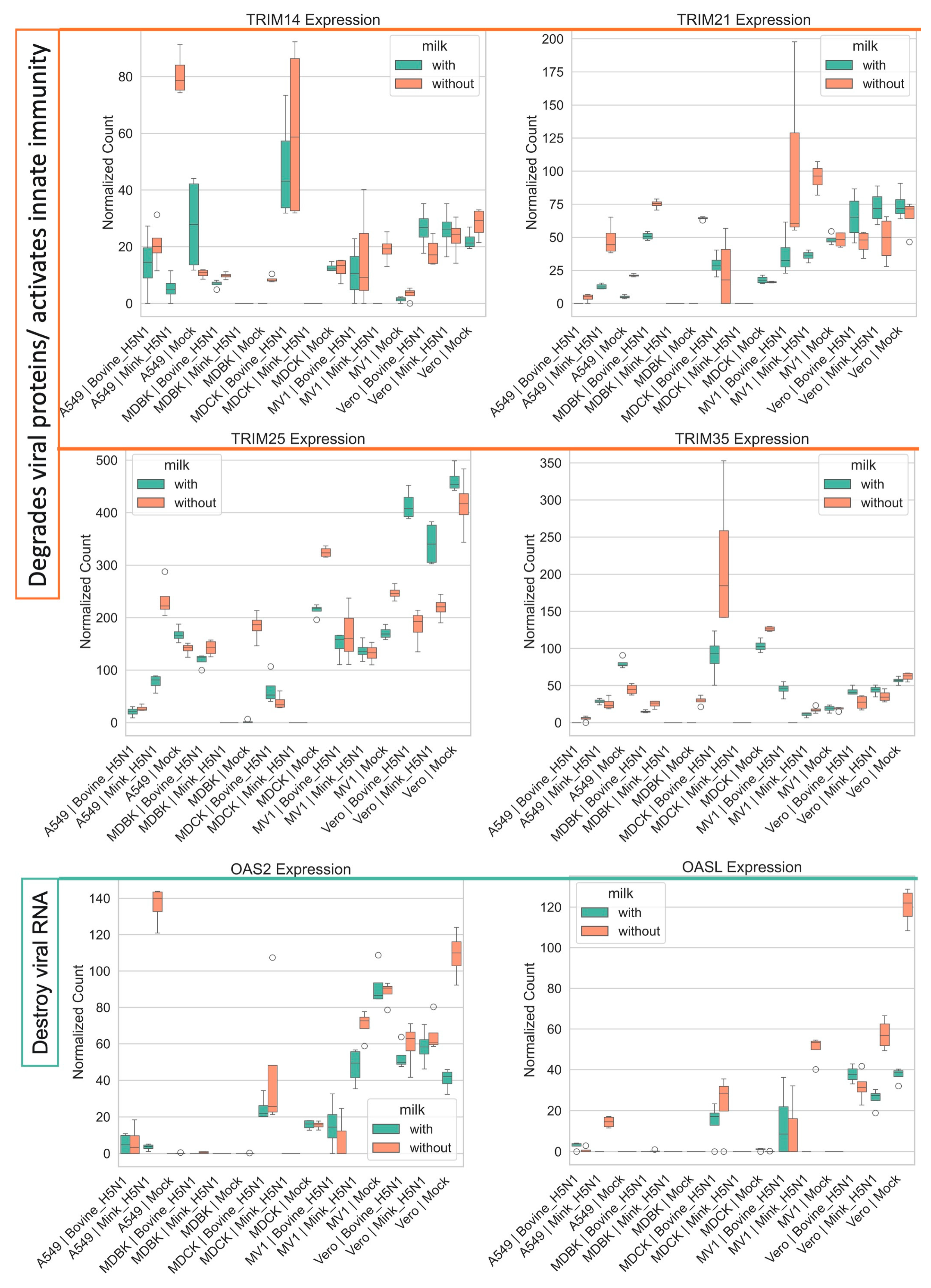


| Cell Line/Virus Isolate | Species | Reference Genome (Assembly and Version) | Source/Accession Number |
|---|---|---|---|
| MDCK | Canis lupus familiaris | CanFam3.1 | NCBI RefSeq assembly accession GCF_000002285.3 |
| MDBK | Bos taurus | ARS-UCD1.2 | NCBI RefSeq assembly accession GCF_002263795.1 |
| A549 | Homo sapiens | GRCh38.p14 | NCBI RefSeq assembly accession GCF_000001405.15 |
| MV1 | Neogale vison (American mink) | ASM_NN_V1 (Mustela_vison-1.0) | NCBI RefSeq assembly accession GCF_020171115.1 |
| Vero | Chlorocebus sabaeus (Green monkey) | Chlorocebus_sabeus 1.1 (chlSab2) | NCBI RefSeq assembly accession GCF_000409795.2 |
| Bovine H5N1 (A/dairy cattle/Kansas/5/2024) | Influenza A virus | NCBI GenBank ID PP732373-80 | |
| Mink H5N1 (A/Mink/Spain/3691-8_22VIR10586-10/2022) | Influenza A virus | GISAID ID EPI2220590-97 |
Disclaimer/Publisher’s Note: The statements, opinions and data contained in all publications are solely those of the individual author(s) and contributor(s) and not of MDPI and/or the editor(s). MDPI and/or the editor(s) disclaim responsibility for any injury to people or property resulting from any ideas, methods, instructions or products referred to in the content. |
© 2025 by the authors. Licensee MDPI, Basel, Switzerland. This article is an open access article distributed under the terms and conditions of the Creative Commons Attribution (CC BY) license (https://creativecommons.org/licenses/by/4.0/).
Share and Cite
Singh, G.; Assato, P.; Fitz, I.; Kafle, S.; Richt, J.A. Differential Host Responses and Viral Replication of Highly Pathogenic Avian Influenza H5N1 Strains in Diverse Cell Lines with a Raw Milk Supplement. Life 2025, 15, 1625. https://doi.org/10.3390/life15101625
Singh G, Assato P, Fitz I, Kafle S, Richt JA. Differential Host Responses and Viral Replication of Highly Pathogenic Avian Influenza H5N1 Strains in Diverse Cell Lines with a Raw Milk Supplement. Life. 2025; 15(10):1625. https://doi.org/10.3390/life15101625
Chicago/Turabian StyleSingh, Gagandeep, Patricia Assato, Isaac Fitz, Sujan Kafle, and Juergen A. Richt. 2025. "Differential Host Responses and Viral Replication of Highly Pathogenic Avian Influenza H5N1 Strains in Diverse Cell Lines with a Raw Milk Supplement" Life 15, no. 10: 1625. https://doi.org/10.3390/life15101625
APA StyleSingh, G., Assato, P., Fitz, I., Kafle, S., & Richt, J. A. (2025). Differential Host Responses and Viral Replication of Highly Pathogenic Avian Influenza H5N1 Strains in Diverse Cell Lines with a Raw Milk Supplement. Life, 15(10), 1625. https://doi.org/10.3390/life15101625






